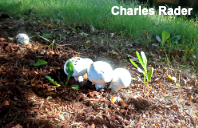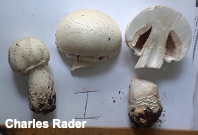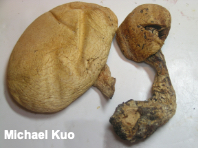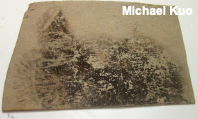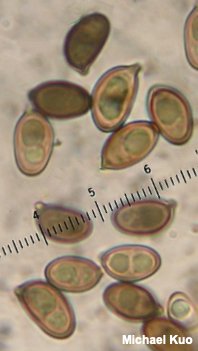| Major Groups > Gilled Mushrooms > Dark-Spored > Agaricus > Agaricus crocodilinus |

|
Agaricus crocodilinus [ Basidiomycota > Agaricales > Agaricaceae > Agaricus . . . ] by Michael Kuo Agaricus crocodilinus is a robust species reminiscent of Agaricus fissuratus; its cap is white, its partial veil often features a cogwheeled underside, and its gills progress from whitish to dark brown without a pink stage. However, unlike Agaricus fissuratus, Agaricus crocodilinus usually features girdles of small scales around the lower stem, and its cap does not have a tendency to turn yellowish with age. Under the microscope Agaricus crocodilinus has larger spores than its look-alikes. In 1912 William Murrill gave this species the epithet crocodilinus because the specimen he collected was, in his words, "conspicuously ornamented with large, gemmate warts originating from the cracking of the epidermus, causing it to resemble the skin of a crocodile." Especially dry conditions appear to have caused the phenomenon, however, and more typical specimens become only finely scaly or cracked. Agaricus macrosporus, Agaricus excellens, and Agaricus kuehnerianus are synonyms. Thanks to Charles Rader for collecting, documenting, and preserving specimens of Agaricus crocodilinus for study; his collection is deposited in The Herbarium of Michael Kuo. Description: Ecology: Saprobic; growing gregariously in grassy areas or in woods; fall or, in warm climates, over winter; possibly widely distributed in North America. The illustrated and described collection is from Massachusetts. Cap: 8–13 cm (or up to 35 cm according to Kerrigan, 2016); convex at first, becoming broadly convex; dry; more or less bald, or finely scaly with whitish tufts, sometimes becoming somewhat scaly with maturity (see discussion above); in dry conditions becoming deeply cracked and scaly (Murrill 1912, Kerrigan 2016); whitish; not bruising when rubbed, or bruising slightly yellow. Gills: Free from the stem; close or crowded; short-gills frequent; whitish to pale brownish when young, becoming dark brown; when in the button stage covered with a whitish partial veil. Stem: 4–10 cm long; 2–3 cm thick; equal or a little club-shaped; bald above but adorned on the lower half with girdles of small white scales; with an ample, white, skirtlike ring that features a "cogwheeled" underside; white; basal mycelium white. Flesh: White; unchanging when sliced. Odor and Taste: Odor reminiscent of almonds; taste not distinctive. Dried Specimens: Cap and stem dull orangish. Chemical Reactions: KOH yellow on surfaces (Kerrigan 2016). Spore Print: Dark brown. Microscopic Features: Spores: 9–11 x 5–6.5 µm; ellipsoid; smooth; thick-walled; brown in KOH; brown in Melzer's. Basidia 4-sterigmate. Cheilocystidia collapsed and poorly differentiated. Pleurocystidia not found. Pileipellis a cutis; elements 2.5–5 µm wide, smooth, hyaline to golden yellow in KOH. REFERENCES: Murrill, 1912. (Kerrigan, 2016.) Herb. Kuo 10041801. This site contains no information about the edibility or toxicity of mushrooms. |
© MushroomExpert.Com |
|
Cite this page as: Kuo, M. (2018, November). Agaricus crocodilinus. Retrieved from the MushroomExpert.Com Web site: http://www.mushroomexpert.com/agaricus_crocodilinus.html |
